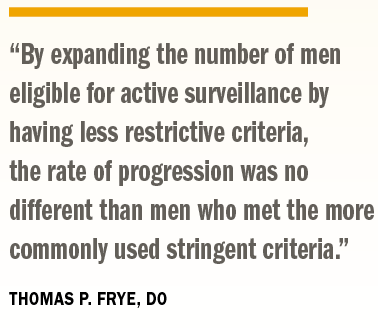Article
Targeted Bx shows efficacy in surveillance cohort
After a median of 2 years in an active surveillance cohort being followed with multiparametric-magnetic resonance imaging and MRI-transrectal ultrasound fusion-guided biopsy (“targeted biopsy”), rates of biopsy-proven pathologic progression are similar among men with low-risk and intermediate-risk disease, say researchers from the National Institutes of Health.
New Orleans-After a median of 2 years in an active surveillance cohort being followed with multiparametric-magnetic resonance imaging (mpMRI) and MRI-transrectal ultrasound fusion-guided biopsy (“targeted biopsy”), rates of biopsy-proven pathologic progression are similar among men with low-risk and intermediate-risk disease, say researchers from the National Institutes of Health (NIH).
READ: Active surveillance for PCa has ‘hit the prime time’
Analyses of data from this cohort also showed a significantly higher proportion of men with pathologic progression were identified by MRI than by other variables, and almost half of the men with pathologic progression were identified by targeted biopsy alone.

Results of the study were presented at the AUA annual meeting in New Orleans.
“The role of active surveillance for men with intermediate-risk prostate cancer is still being investigated. Recent studies and our data suggest that with better visualization afforded by MRI and better individual risk stratification using targeted biopsy, we may be able to safely survey some of these men,” said first author Thomas P. Frye, DO, clinical fellow in urologic oncology at the NIH, Bethesda, MD.
“In addition, our data indicate that MRI can improve prediction of patients who have pathologic progression, and with targeted biopsy, it could allow for a more accurate risk assessment of these men,” added Dr. Frye, who worked on the study with Peter A. Pinto, MD, and colleagues.
READ: Prostate Ca radiation therapy cost drivers analyzed
All men entered into the active surveillance program at the NIH undergo a confirmatory targeted biopsy. Men selected for the retrospective review presented by Dr. Frye had at least one follow-up mpMRI and targeted biopsy, Gleason ≤7 (≤3+4) disease, and no evidence of extracapsular extension or seminal vesicle invasion on mpMRI. They included 98 men with low-risk disease (Gleason ≤6) and 26 men with intermediate-risk disease (Gleason ≤3+4=7). The two risk groups were similar in mean age and mean PSA, and the intermediate-risk men had very-low-volume Gleason 7 disease, with the majority having just one or two positive cores.
NEXT: progression similiar in risk cohorts
Progression similar in risk cohorts
During the available follow-up, pathologic progression was found in 28 men (28.5%) in the low-risk group and 10 intermediate-risk men (38.5%). The difference between groups was not statistically significant. Median time to progression in the two risk groups was 3.5 years and 2.8 years, respectively, and Kaplan-Meier survival analysis showed no statistically significant difference to date in pathologic progression-free survival between the low- and intermediate-risk groups. However, Dr. Frye noted the study is a retrospective analysis and not a prospective investigation powered to detect differences in pathologic progression-free survival.
READ: Biomarkers offer insight into PCa racial disparity
Rate of pathologic progression was also analyzed among men in this cohort who would have been selected for active surveillance using different criteria (Epstein, Toronto, PRAS, and Royal Marsden), and it was consistently around 30%.
“We did not set criteria for number of positive cores or volume of core involvement to define our risk groups because we wanted to see if those factors had any bearing on progression in a cohort followed with targeted biopsy,” Dr. Frye said.
“The take-away message is that by expanding the number of men eligible for active surveillance by having less restrictive criteria, the rate of progression was no different than men who met the more commonly used stringent criteria.”
In both the low-risk and intermediate-risk groups, pathologic progression was found by targeted biopsy in about 70%.
“Looking at the precision of the targeted biopsy to identify men with pathologic progression, we found that in both the low-risk and intermediate-risk groups, about five times more random biopsies than targeted biopsies would be needed to detect progression,” Dr. Frye said.
READ: Upfront chemo called ‘standard’ in hormone-naïve PCa
In analyses to investigate how well mpMRI progression predicts pathologic progression, three criteria were used to define MRI progression: increase in suspicion score, increase in lesion size, or development of new lesions.
Dr. Frye reported that pathologic progression was found in 38% of 79 men who met at least one of the three criteria for MRI progression and in 18% of the 45 men who did not have MRI progression. The difference between groups was statistically significant, and MRI progression had a negative predictive value of 82%, a sensitivity of 79%, and a specificity of 43%.
The risk of pathologic progression increased as the number of criteria for MRI progression increased. All men who met all three criteria for defining MRI progression and 45% who met two criteria were found to have pathologic progression.
Among the 38 men who had pathologic progression, it was found by targeted biopsy alone in 18 men (47%) and by random biopsy alone in 11 (29%).
“Doing targeted biopsy almost doubled the number of men that had biopsy-proven progression, and MRI appeared to be very helpful because 16 of the 18 men found by targeted biopsy alone had evidence of MRI progression,” Dr. Frye said.















